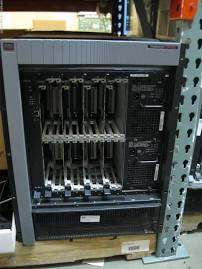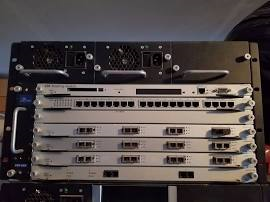Ericsson / Marconi / Fore Systems ATM Switches
 Founded in 1990 to supply a US Naval Research Laboratories request for development, FORE Systems initially produced ATM network interface cards for SBus and TURBO channel-based computers in addition to ATM adapters for Silicon Graphics computers. FORE’s first ATM Switch, the ASX-100, connected 16 ATM ports each with a capacity of 155.52 Mbps. Later interface adapters for the follow-on ASX-200, ASX-1000, and ASX-4000 switches allowed connections up to 2.5 Gb/s. FORE created a memory-based ATM switch that captured a large portion of the ATM market. The company became a major leader in the market for ATM switching equipment. FORE was created by four Carnegie Mellon University professors in the Pittsburgh suburb of Warrendale, Pennsylvania. The name FORE was an acronym of the founders’ first names: Francois Bitz, Onat Menzilcioglu, Robert Sansom, and Eric Cooper. In 1999, Marconi PLC acquired FORE Systems, Inc. In 2006, Ericsson purchased most of Marconi, including the part that used to be FORE Systems The installed base of Marconi switches, in addition to those used by global carriers and telephone company providers, includes hospitals, college campuses, metropolitan transit authorities, global publishers, and the airline, steel, petroleum, and manufacturing industries. Ericsson officially ended all sustaining engineering support on December 31,2012.
Founded in 1990 to supply a US Naval Research Laboratories request for development, FORE Systems initially produced ATM network interface cards for SBus and TURBO channel-based computers in addition to ATM adapters for Silicon Graphics computers. FORE’s first ATM Switch, the ASX-100, connected 16 ATM ports each with a capacity of 155.52 Mbps. Later interface adapters for the follow-on ASX-200, ASX-1000, and ASX-4000 switches allowed connections up to 2.5 Gb/s. FORE created a memory-based ATM switch that captured a large portion of the ATM market. The company became a major leader in the market for ATM switching equipment. FORE was created by four Carnegie Mellon University professors in the Pittsburgh suburb of Warrendale, Pennsylvania. The name FORE was an acronym of the founders’ first names: Francois Bitz, Onat Menzilcioglu, Robert Sansom, and Eric Cooper. In 1999, Marconi PLC acquired FORE Systems, Inc. In 2006, Ericsson purchased most of Marconi, including the part that used to be FORE Systems The installed base of Marconi switches, in addition to those used by global carriers and telephone company providers, includes hospitals, college campuses, metropolitan transit authorities, global publishers, and the airline, steel, petroleum, and manufacturing industries. Ericsson officially ended all sustaining engineering support on December 31,2012.
ATM Technology Basics
 According to ATM Forum, ATM is a telecommunications concept defined by the American National Standards Institute (ANSI) and the International Telecommunications Union (ITU) standards for carriage of a complete range of user traffic including voice, data, and video signals. It uses asynchronous time-division multiplexing, and it encodes data into small, 53 byte cells. This differs from approaches such as IP or Ethernet that use variable sized packets or frames. ATM provides data link layer services that run over a wide range of Open Systems Interconnection’s (OSI) physical layer links. It has functional similarity with both circuit-switched networking and small packet-switched networking. It was designed for today’s network that must handle both traditional high-throughput data traffic such as file transfers, and real-time low-latency content such-as voice and video. ATM uses a connection-oriented model in which a virtual circuit must be established between two endpoints before the actual data exchange begins. It is a core protocol used over the Synchronous Optical Network (SONET)/Synchronous Digital Hierarchy (SDH) backbone of the Public Switched Telephone Network (PSTN) and Integrated Services Digital Network (ISDN). Perhaps the main reason that these switches, which ZT Technology supports, have such longevity is that they perform packet switching. These include the carrier class ASX-1000, TNX-1100, TNX-1200, and ASX-4000. These switches have 10 to 40 Gbps switch fabrics with 2 to 96 OC48 ports. Switch transit delay is less than 11 microseconds, so these CO based switches can forward over 90 million packets per second.
According to ATM Forum, ATM is a telecommunications concept defined by the American National Standards Institute (ANSI) and the International Telecommunications Union (ITU) standards for carriage of a complete range of user traffic including voice, data, and video signals. It uses asynchronous time-division multiplexing, and it encodes data into small, 53 byte cells. This differs from approaches such as IP or Ethernet that use variable sized packets or frames. ATM provides data link layer services that run over a wide range of Open Systems Interconnection’s (OSI) physical layer links. It has functional similarity with both circuit-switched networking and small packet-switched networking. It was designed for today’s network that must handle both traditional high-throughput data traffic such as file transfers, and real-time low-latency content such-as voice and video. ATM uses a connection-oriented model in which a virtual circuit must be established between two endpoints before the actual data exchange begins. It is a core protocol used over the Synchronous Optical Network (SONET)/Synchronous Digital Hierarchy (SDH) backbone of the Public Switched Telephone Network (PSTN) and Integrated Services Digital Network (ISDN). Perhaps the main reason that these switches, which ZT Technology supports, have such longevity is that they perform packet switching. These include the carrier class ASX-1000, TNX-1100, TNX-1200, and ASX-4000. These switches have 10 to 40 Gbps switch fabrics with 2 to 96 OC48 ports. Switch transit delay is less than 11 microseconds, so these CO based switches can forward over 90 million packets per second.
* – ZT Technology Solutions is an independent company and has no affiliation with Ericsson.
